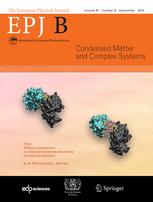Home > Press > On-demand conductivity for graphene nanoribbons: Physicists from Uzbekistan and Germany have devised a theoretical model to tune the conductivity of graphene zigzag nanoribbons using ultra-short pulses
 |
Abstract:
Physicists have, for the first time, explored in detail the time evolution of the conductivity, as well as other quantum-level electron transport characteristics, of a graphene device subjected to periodic ultra-short pulses. To date, the majority of graphene studies have considered the dependency of transport properties on the characteristics of the external pulses, such as field strength, period or frequency. The new findings have now been published in EPJ B by Doniyor Babajanov from the Turin Polytechnic University in Tashkent, Uzbekistan, and colleagues. These results may help to develop graphene-based electronic devices that only become conductors when an external ultra-short pulse is applied, and are otherwise insulators.
On-demand conductivity for graphene nanoribbons: Physicists from Uzbekistan and Germany have devised a theoretical model to tune the conductivity of graphene zigzag nanoribbons using ultra-short pulses
Heidelberg, Germany and New York, NY | Posted on November 10th, 2014he authors' focus is on the transport in graphene nanoribbons driven by laser pulses, which were chosen for their ability to apply periodic kicks to the system. Babajanov and colleagues relied on driven quantum systems and quantum chaos theories to study transport characteristics within the nanoribbon. For a single kicking period, they obtained the exact solution of a mathematical equation, called the time-dependent Dirac equation. Then, by iterating this solution they were able to numerically and precisely compute the arbitrary characteristics of time-dependent quantum transport of electrons within the material.
They found that applying external driving force leads to enhancement of electronic transitions within what are referred to as valence and conduction bands. This study thus demonstrates that such transitions allow a dramatic increase in conductivity within a short time, making it possible to tune the electronic properties using short external pulses.
The next stage could be extending the test to the case of a time-dependent magnetic field, to strain-induced pseudo-magnetic fields, or to external monochromatic fields. Ultimately, this could lead to useful applications such as ultrafast electronic switches.
####
For more information, please click here
Contacts:
Laura Zimmermann
49-622-148-78414
Copyright © Springer
If you have a comment, please Contact us.Issuers of news releases, not 7th Wave, Inc. or Nanotechnology Now, are solely responsible for the accuracy of the content.
| Related Links |
| Related News Press |
News and information
![]() Researchers develop molecular qubits that communicate at telecom frequencies October 3rd, 2025
Researchers develop molecular qubits that communicate at telecom frequencies October 3rd, 2025
![]() Next-generation quantum communication October 3rd, 2025
Next-generation quantum communication October 3rd, 2025
![]() "Nanoreactor" cage uses visible light for catalytic and ultra-selective cross-cycloadditions October 3rd, 2025
"Nanoreactor" cage uses visible light for catalytic and ultra-selective cross-cycloadditions October 3rd, 2025
Graphene/ Graphite
![]() Electrifying results shed light on graphene foam as a potential material for lab grown cartilage June 6th, 2025
Electrifying results shed light on graphene foam as a potential material for lab grown cartilage June 6th, 2025
![]() Breakthrough in proton barrier films using pore-free graphene oxide: Kumamoto University researchers achieve new milestone in advanced coating technologies September 13th, 2024
Breakthrough in proton barrier films using pore-free graphene oxide: Kumamoto University researchers achieve new milestone in advanced coating technologies September 13th, 2024
Discoveries
![]() Researchers develop molecular qubits that communicate at telecom frequencies October 3rd, 2025
Researchers develop molecular qubits that communicate at telecom frequencies October 3rd, 2025
![]() Next-generation quantum communication October 3rd, 2025
Next-generation quantum communication October 3rd, 2025
![]() "Nanoreactor" cage uses visible light for catalytic and ultra-selective cross-cycloadditions October 3rd, 2025
"Nanoreactor" cage uses visible light for catalytic and ultra-selective cross-cycloadditions October 3rd, 2025
Announcements
![]() Rice membrane extracts lithium from brines with greater speed, less waste October 3rd, 2025
Rice membrane extracts lithium from brines with greater speed, less waste October 3rd, 2025
![]() Researchers develop molecular qubits that communicate at telecom frequencies October 3rd, 2025
Researchers develop molecular qubits that communicate at telecom frequencies October 3rd, 2025
![]() Next-generation quantum communication October 3rd, 2025
Next-generation quantum communication October 3rd, 2025
![]() "Nanoreactor" cage uses visible light for catalytic and ultra-selective cross-cycloadditions October 3rd, 2025
"Nanoreactor" cage uses visible light for catalytic and ultra-selective cross-cycloadditions October 3rd, 2025
Interviews/Book Reviews/Essays/Reports/Podcasts/Journals/White papers/Posters
![]() Spinel-type sulfide semiconductors to operate the next-generation LEDs and solar cells For solar-cell absorbers and green-LED source October 3rd, 2025
Spinel-type sulfide semiconductors to operate the next-generation LEDs and solar cells For solar-cell absorbers and green-LED source October 3rd, 2025
![]() Rice membrane extracts lithium from brines with greater speed, less waste October 3rd, 2025
Rice membrane extracts lithium from brines with greater speed, less waste October 3rd, 2025
Quantum nanoscience
![]() ICFO researchers overcome long-standing bottleneck in single photon detection with twisted 2D materials August 8th, 2025
ICFO researchers overcome long-standing bottleneck in single photon detection with twisted 2D materials August 8th, 2025
![]() Programmable electron-induced color router array May 14th, 2025
Programmable electron-induced color router array May 14th, 2025
|
|
||
|
|
||
| The latest news from around the world, FREE | ||
|
|
||
|
|
||
| Premium Products | ||
|
|
||
|
Only the news you want to read!
Learn More |
||
|
|
||
|
Full-service, expert consulting
Learn More |
||
|
|
||








